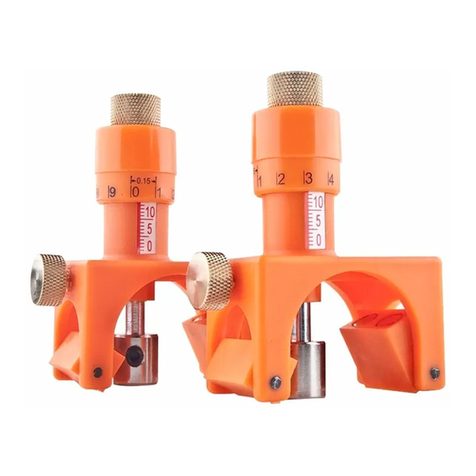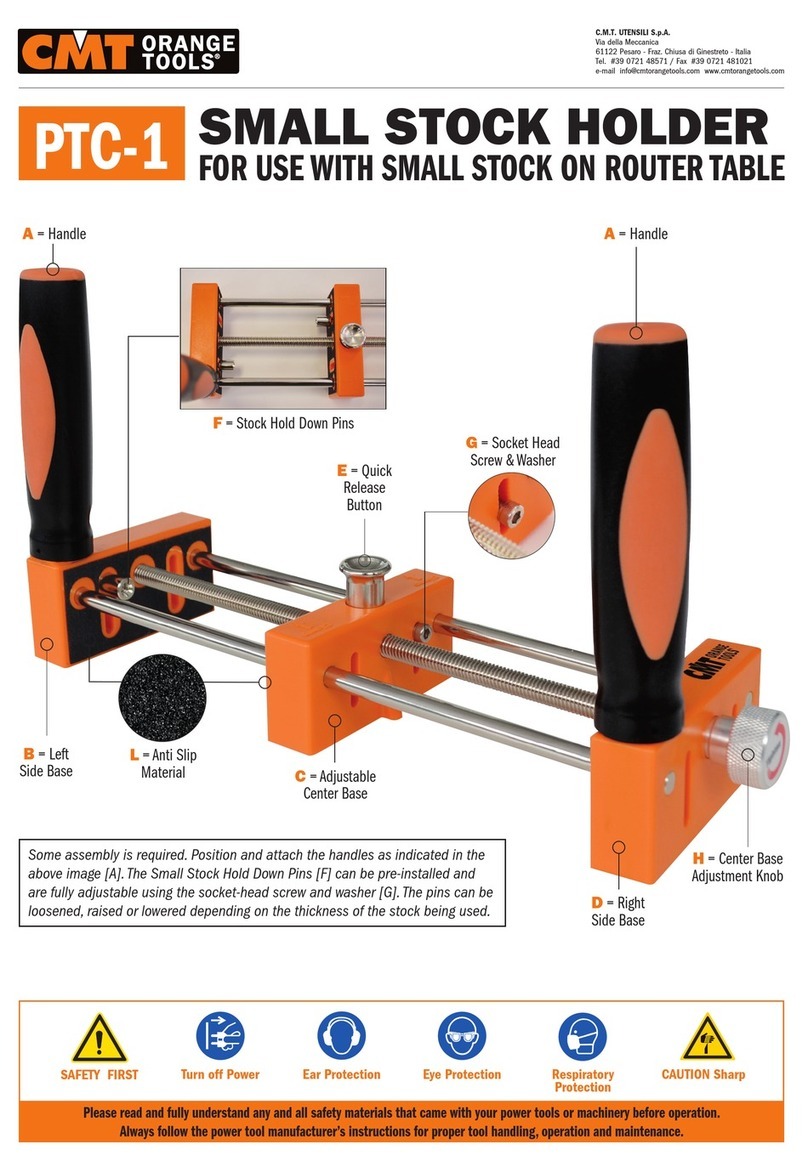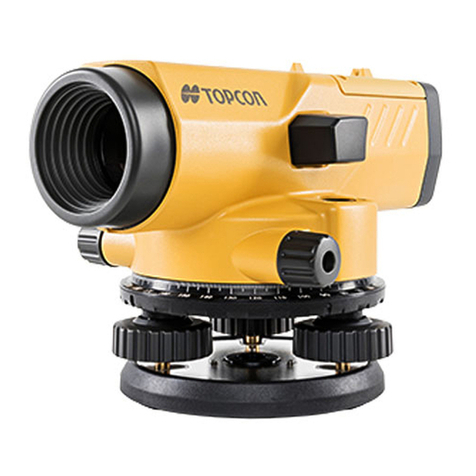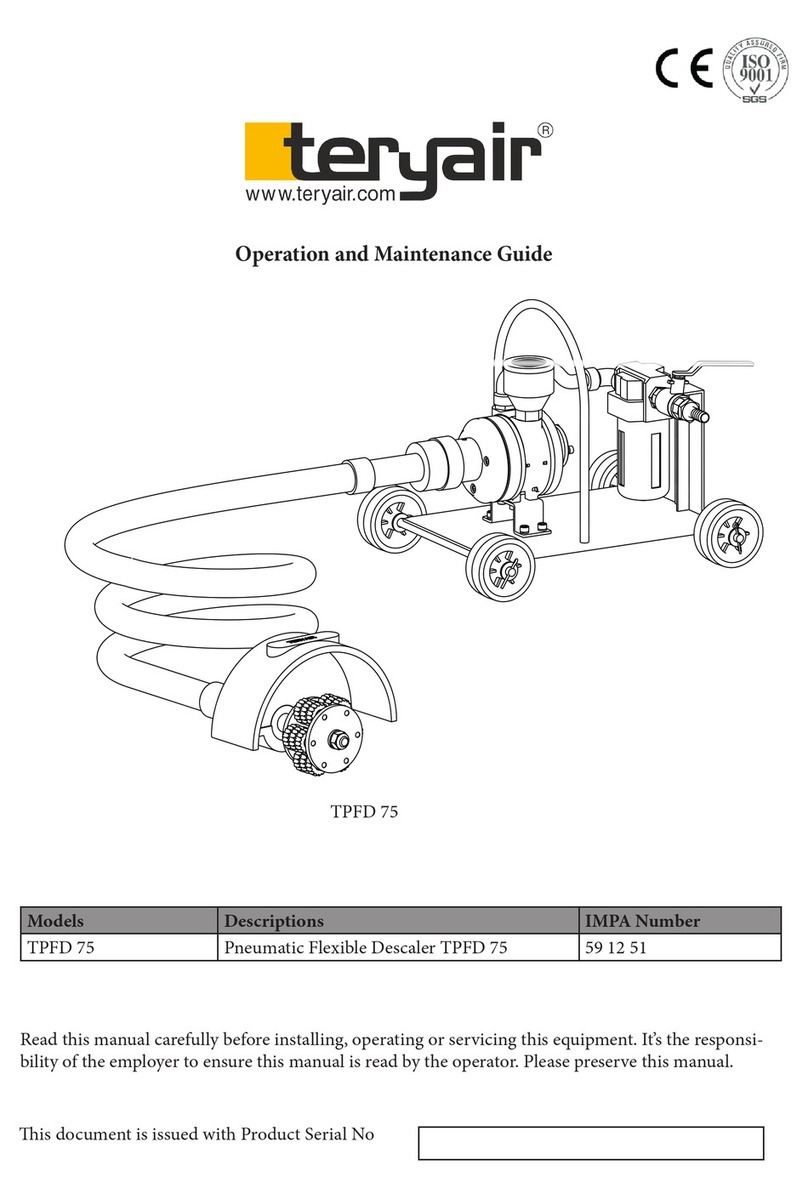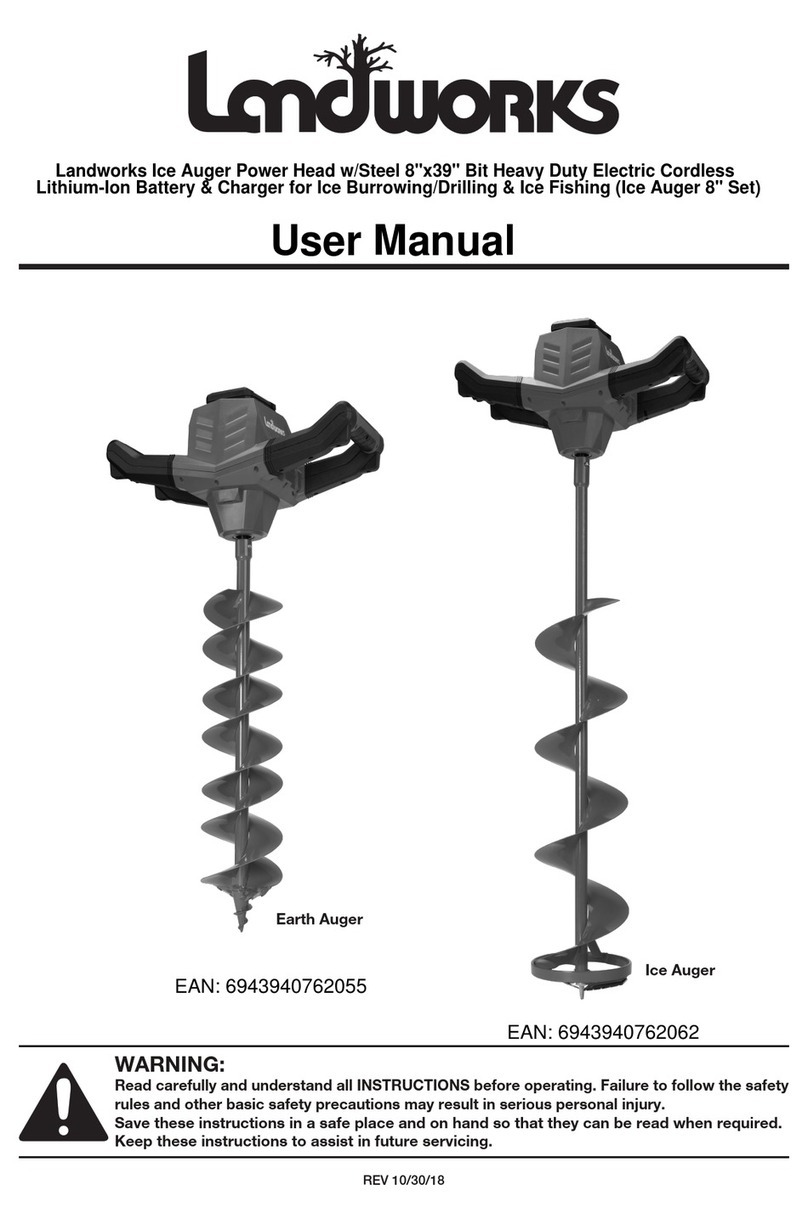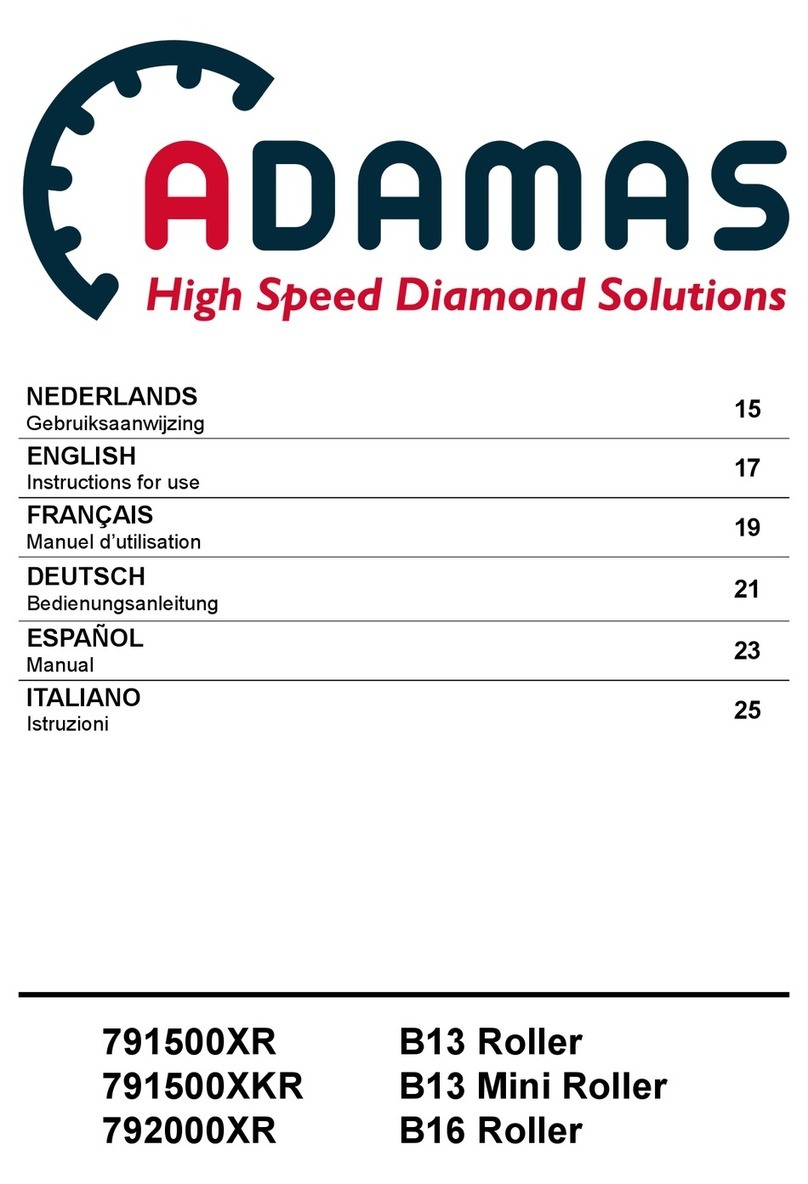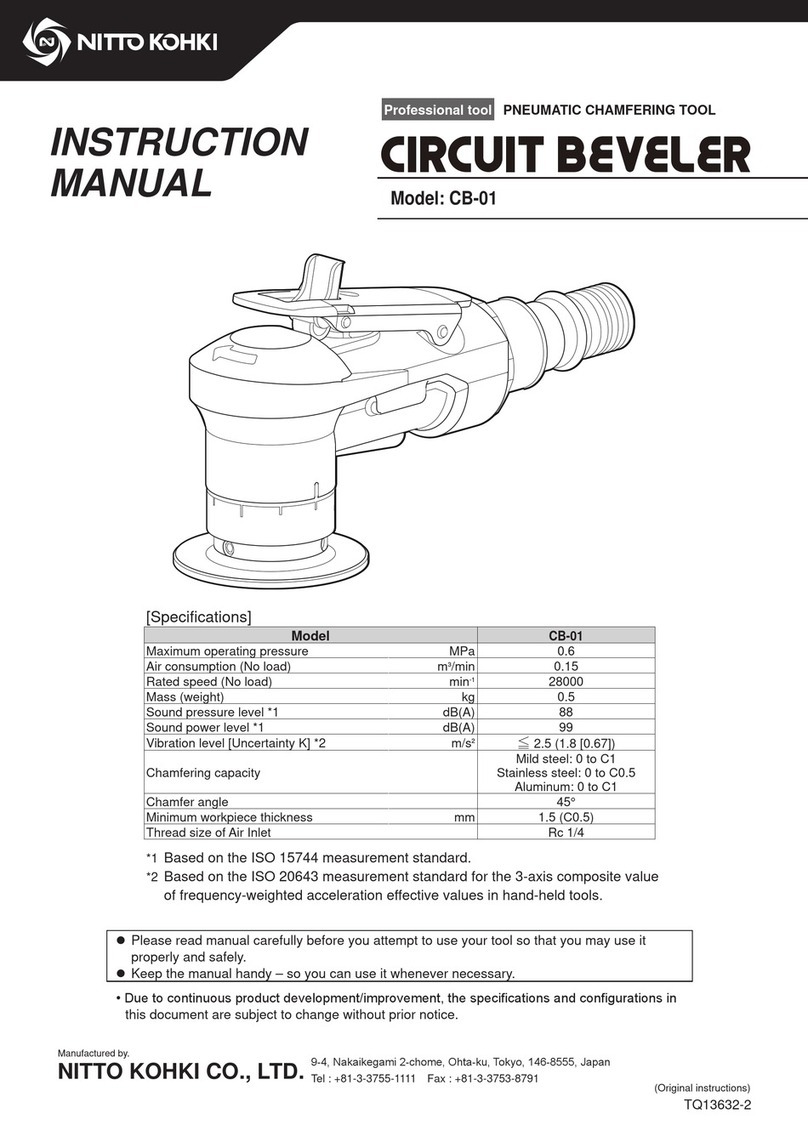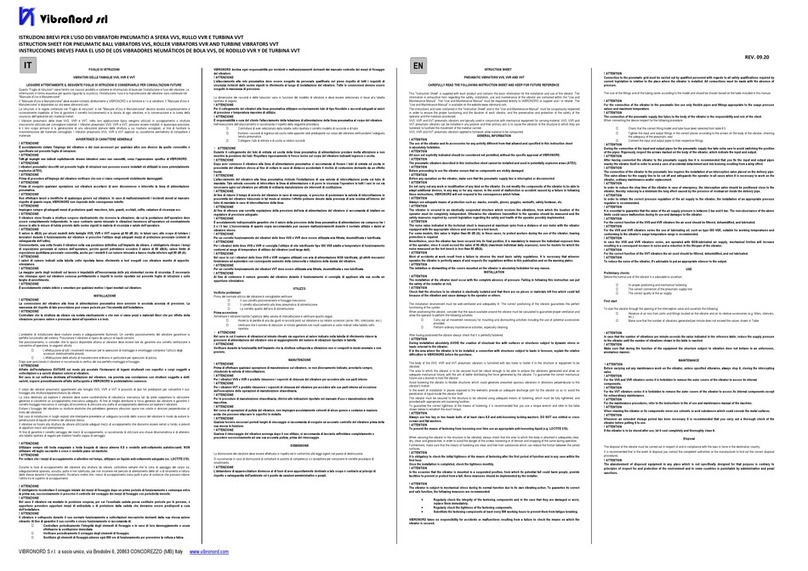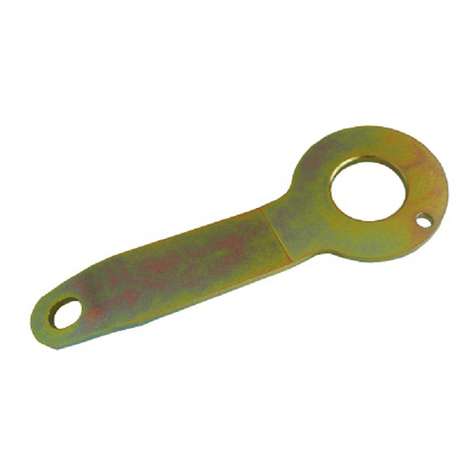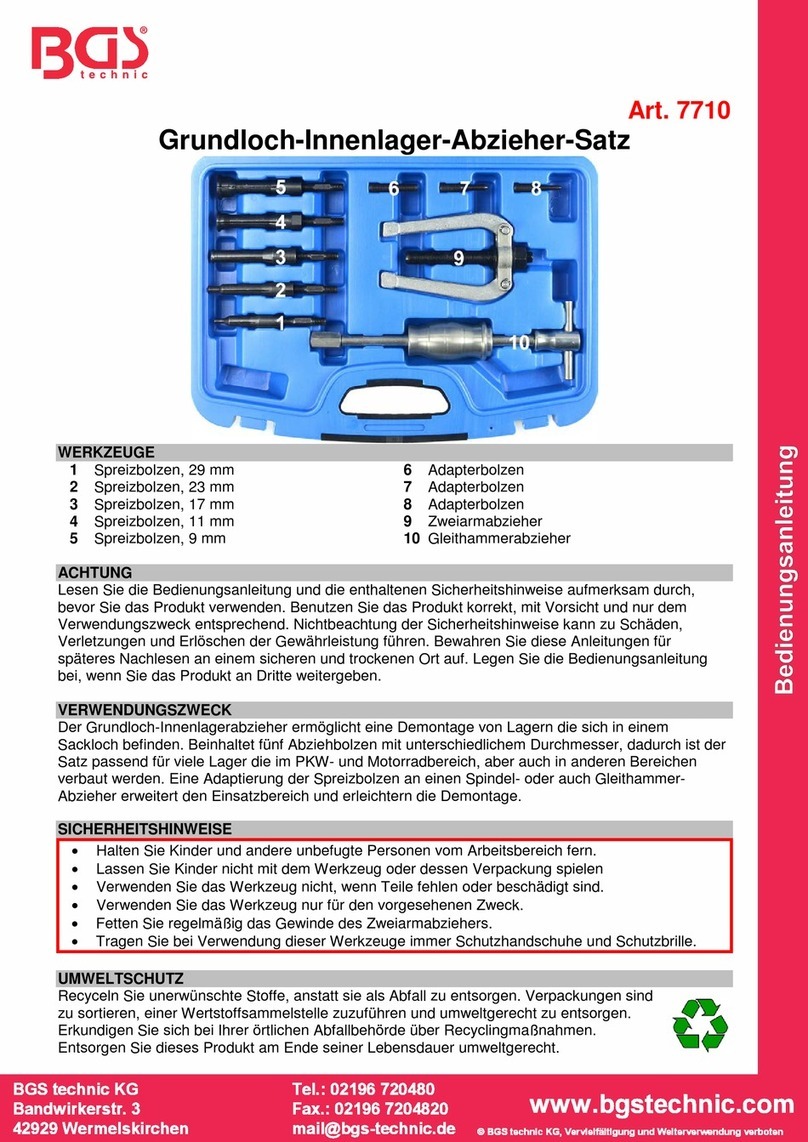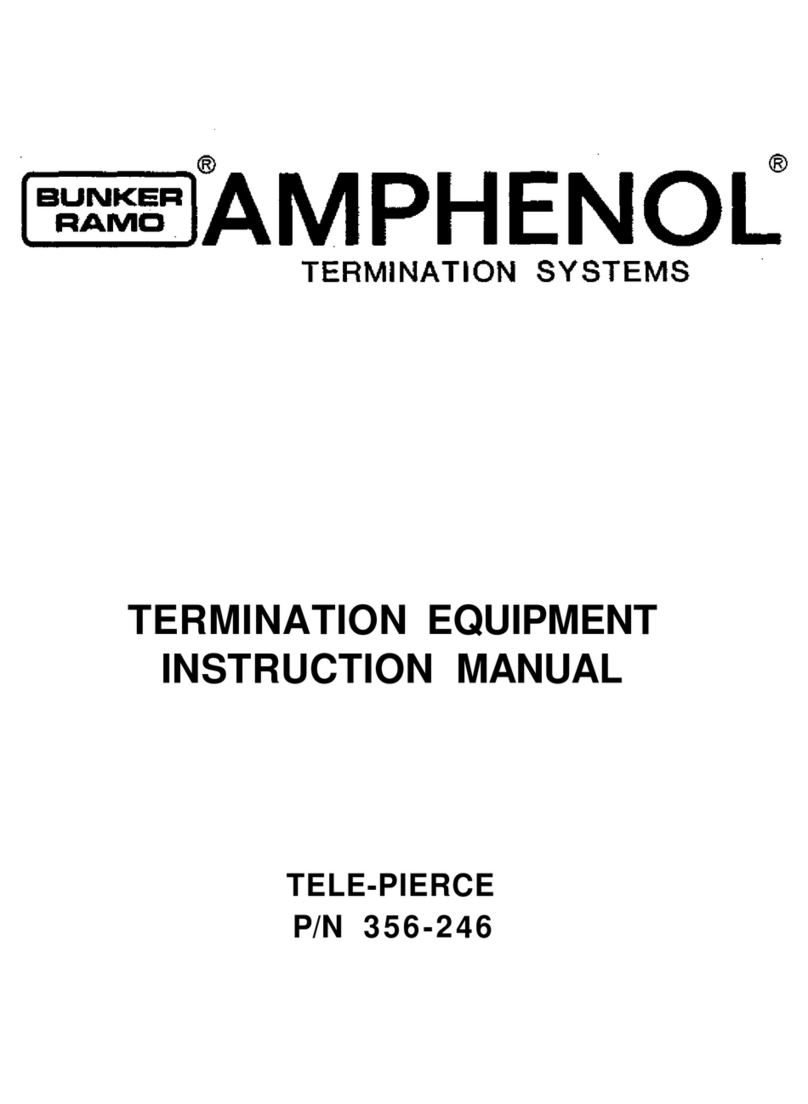CMT BTS-002 User manual

BTS-002 - CMT Bowl and Tray Kit
Owner’s Manual
Thank you for purchasing the CMT Bowl and Tray Kit. With this kit you can make platters and bowls up to 70mm deep. Bowls and platters
make great gifts, and they’re a great way to use up scrap wood. There’s no end to the different combinations of wood and shapes you can
create with this kit. Please read all the instructions thoroughly before using the BTS-002 kit.
Tool Requirements
- 1300 watt or larger plunge router with variable speed
- Forstner bit, 35mm or larger
- 12,7mm radius roundover bit (CMT #938.880.11 w/ 12mm shank, or,
#938.380.11, w/8mm shank)
- Drill Press (Note: The bowl can be excavated with a router only.
It just takes longer and puts more wear and tear on your router and bit.)
- Soft disc sanding pads designed for bowl turning for sanding bowl interior.
(Available where turning supplies are sold.)
- Compass
Get Started
Unpack the CMT Bowl and Tray Kit,
which includes a Bowl and Tray
bit, collet extension and two bowl
templates.
Glue up a bowl blank. Make an 460x460mm blank to use with the round bowl template
and a 380x590mm blank for the oval template. Thick stock works best, but you can stack-
laminate thinner boards to build the blank to the desired depth.
Note: A 70mm deep bowl is about the max for most routers.
You can mix woods in your bowl blank. A layer of contrasting wood at the top is a nice
touch. Like bowl turners, you can have a lot of fun experimenting with different woods and
different glue-up patterns to achieve stunning results. It’s important to align your boards
perfectly flush in the clamps to avoid unnecessary sanding to flatten out the blank. This is
especially true if you are going to stack-laminate or add an accent layer as shown here.
Lay out the bowl using the template. Center the template on the blank and mark the
first partition. Remove the template and make marks exactly 12,7mm from the edge of
the first partition. This defines the wall thickness for each partition. It’s important to be
exact in order to achieve a uniform wall thickness for all the partitions. Use these marks
to align the template for the two adjoining partitions. Make additional marks to position
the template for the last partition.
Use a Forstner bit in a drill press to remove most of the wood. Forstner bits do the best
job because they can make overlapping cuts and leave a flat bottom.
Drill the holes to within 3,2mm of your layout lines. Set the depth of cut to stop short of
the finished bottom so the router bit can clean up the dimples left by the center point in
the Forstner bit.
Note: It’s best to use a bit whose diameter is larger than the 31,75mm diameter Bowl
and Tray Bit. If you must use a Forstner bit less than 31,75mm, don’t cut too close into
the corners or the router bit won’t be able to clean it up.
Once the partitions have been excavated on the drill press, it’s time to move on to the
router. First, make an extension router base plate that’s large enough to safely bridge the
opening in the template. The base plate can be made of 12,7mm sheet stock or 9,5mm
thick acrylic or polycarbonate plastic. Drill a 50,8mm hole in the middle of the plate.
Mount the extension base to your router.
Next, assemble the collet extension using a 14mm and an 18mm wrench. Insert the
bowl-cutting bit into the collet and tighten using a 27mm wrench and the 18mm wrench.
Warning: You must have at least 2/3 of the bit’s shaft length inside the collet. Do not
try and extend the depth of cut by overextending the bit from the collet.
Insert the collet extension into the router and tighten.
Note: Be certain to unplug the router whenever changing bits or making adjustments to
the router.
Mount the template on the blank so it lines up exactly with the previously drawn lines.
Drill and countersink at least two holes in the template. Be sure to locate the holes over
the waste portions of the bowl where they will be removed later. Fasten the template onto
the blank with flat head screws. Make sure the screw heads are set just below the surface
of the template so they don’t interfere with the router.
Set the plunge router’s turret stop for a cut deep enough to finish the bottom of the
bowl.To do this, set the router on top of the template on the bowl blank and plunge the
unplugged router down until the bit bottoms out. Set the stop so the bit will plunge ano-
ther 3,2mm - 4,7mm beyond the drilled out bottom and remove the dimples left by the
Forstner bit’s center point.
Finally, be certain that at the top of the router’s travel the bearing on the router bit is riding
on the template. This sets the router for the first pass. If your router has a chip collection
attachment, be sure to use it.
Secure the blank to your bench. With the plunge mechanism set at the top of its travel,
place the router over an open area on the template. Make sure the cutter is not contac-
ting the wood and turn on the router. Gently slide the router to the template edge and
begin your cut. Continue the cut around the opening.
Then, lower the bit 9,5mm and make another pass. Eventually the bearing on the bit will
drop below the template and begin to register on the wall of the bowl itself. Keep making
Watch the video on

An edge or disc sander will make quick work of this job but be careful; they can just as
quickly cut a facet on the edge and ruin the piece. You can also sand the exterior using
a random orbit sander.
With the bowl sanded round and the band saw marks removed, head to the router table
for some final shaping. Mount a 12,7mm roundover bit in the router and round over the
bottom edge of the bowl.
To rout the top edges of the partitions, mount a 6,35mm roundover in the table, remove
the fence and set the bowl upside down so the bit is inside one of the quadrants. Make
sure the bit is not in contact with the bowl. Turn the router on and rout the inside edge of
the partition. Turn the router off and let it spin down to a stop. Reposition the bowl over
the bit and rout the next partition. Repeat this process for all four partitions and the dip
cup hole. Rout the outside top edge of the bowl with the same bit.
Sand the interior of the bowl using a soft disc. These discs are commonly used by lathe
turners on lathe-turned bowl interiors. Start with 80-grit and work your way up to 220-grit.
Finish sanding the outside with an orbital sander. Now you’re ready to apply a finish.
A great food safe finish for wood is walnut oil. You’ll find it at most health food stores.
It dries hard and is totally non-toxic. Other food safe finishes include mineral oil, salad
bowl finish and shellac.
®: CMT, the CMT logo and the orange color applied to tool surfaces are trademarks
of C.M.T. UTENSILI S.P.A.
© C.M.T. UTENSILI S.P.A.
This document has been sent for your personal use only.
All usage and reproduction is forbidden without written permission from C.M.T. UTENSILI S.P.A.
progressively deeper cuts until you reach the bottom of the bowl. Then, sweep the router
back and forth to clean up the bottom. Don’t worry about the slight ridges left by the router
bit. These will clean up easily with a disk sander.
Turn the router off and let it stop before lifting it from the bowl. Move the template to
the next quadrant and repeat the process until all four partitions and the center hole
are complete.
The next step is to lay out the outside wall of the bowl. Set a compass to mark a little
over 12,7mm to allow for sanding. Make sure the compass point extends about 6,35mm
or so past the pencil point.
Hook the pivot point just inside the rim of the bowl and run the compass around the bowl.
Always keep the line from the pencil point to the pivot point perpendicular to the rim.
To bridge the gaps in the outline that occurs at the partitions, bend a thin piece of wood
along the existing lines and pencil in the break.
Take the blank to the bandsaw and cut off the excess stock. Take care to cut up to the
layout line. Go slowly and do your best to make the cut smooth and accurate. It’ll save
you a lot of sanding later.
The bowl will come off the band saw round but rough. Sand the band sawn edge smooth
and fair. A good way to sand the edge on a round bowl is to use a sanding belt. Pencil
marks on the outside edge tell you where the low spots are and where you’ve sanded.
Clamp the bowl blank in a vise (use scrap wood to protect the bowl form iron jaws) and
sand the edge like a shoeshine polishes a shoe.
C.M.T. UTENSILI S.p.A.
Via della Meccanica
61122 Pesaro
Fraz. Chiusa di Ginestreto - Italia
Phone #39 0721 48571
Fax #39 0721 481021
www.cmtorangetools.com
C.M.T. UTENSILI, Sucursal en España
Calle 25/31 Poligono Industrial
46470 Catarroja - Valencia - España
Tel. #34 96 1274500
Fax #34 96 1262754
03.60.0274

BTS-002 – Sistema CMT para bandejas
Manual de instrucciones
¡Muchas gracias por haber comprado CMT BTS-002! Por medio de este KIT usted podrá crear banjedas de hasta 70mm de profundidad,
como regalo para sus amigos, o como objeto para decorar su casa o su habitación. ¡Realice todo lo que quiera! Lea atentamente el manual
de intrucciónes antes de utilizar.
Requisitos
- Fresadora de velocidad de rotación variable de 1300 W. o superior;
- Broca Forstner de diámentro 35mm o superior;
- Fresa de radio cóncavo CMT 938.880.11 de mango 12mm o CMT 938.380.11
de mango 8mm;
- Taladro de columna (N.B. se puede también fresar en profundidad usando una
fresadora, aunque usted necesitaría más tiempo y podría desgastar tanto la
máquina como la fresa);
- Un disco para lijar las bandejas;
- Un compás.
Para empezar
El kit incluye la fresa
para crear bandejas,
un mandril y dos moldes.
Encole varias piezas de madera para crear un bloque de tamaño 460x460mm sobre el
cual usted usará su molde en forma de banjeda, y un bloque de 380x590mm sobre el
cual usted usará el molde de forma oval. Aconsejamos utilizar material bastante grueso
o varios paneles laminados más finos.
Nota.La mayoría de las fresadoras permiten fresados de hasta 70mm de profundidad.
Usted podrá fabricar el bloque y la parte superior en maderas diferentes, para que así
tenga un contraste visual agradable. Alinee bien las piezas antes de pegarlas, para
garantizar un buen apriete del bloque sin necesidad de lijarlo, en particular para los
bloques de laminados o de otro tipo de madera, como puede ver en la imagen.
Posicione el molde sobre la parte central del bloque y dibuje el primer cuadrante como
en la imagen. Quite el molde y dibuje un signo a 12,7mm del borde marcado para definir
el espesor de la bandeja. Es importante crear todos los cuadrantes iguales. Alinee el
molde a las marcas para crear los otros cuadrantes, asì que se reproduzca la forma de
una bandeja.
Quite el máximo material posible del bloque utilizando una broca Forstner en un taladro
de columna. Taladre hasta una distancia de 3,2mm de las marcas dibujadas y ajuste
la profundidad de taladro para evitar tocar el fondo de la bandeja. Los desechos de
materiales dejados por la broca serán quitados por la fresa para bandejas incluida en
el embalaje.
Nota. Se aconseja utilizar una broca Forstner con diámetro de corte mayor que 31,75
(medida de la fresa para bandejas). Si el diámetro de la broca fuera más pequeño, no
frese demasiado cercano a las equinas, ya que la fresa no quitará completamente los
desechos de materiales.
Cuando haya finalizado con el taladro, pase a su fresadora. Cree una base de madera
de espesor 12,7mm o de plástico de policarbonato o acrílico de espesor 9,5mm para
fresar de manera segura. Taladre el agujero en el medio de la bandeja hasta 50,8mm de
profundidad, monte la base en su fresadora, inserte el mandril utilizando una llave de
14mm y de 18mm. Inserte la fresa en el mandril y aprietela por medio de una llave de
27mm y de 18mm.
Cuidado: compruebe que al menos 2/3 del mango de la fresa se introduzcan
correctamente en el mandril. No trate de alargar la profundidad de corte de otras
maneras. Inserte el mandril en la fresadora y apriételo.
Nota: asegúrese de que su fresadora esté desconectada de la red electrica cuando
efectúe ajustes o reemplace su fresa. Posicione el molde sobre el bloque en parte
trabajado, de forma que esté alineado con las marcas dibujadas y apriételo por medio
de tornillos de cabeza plana. Inserte los tornillos bajo el molde para no interferir con
su fresadora. Posicione su fresadora sobre el molde poniendo la fresa en contacto con
el fondo de la bandeja, permitiendo una posterior profundidad de corte entre 3,2 y
4,7mm para quitar los desechos de materiales dejados por la broca Forstner. Conecte su
fresadora a la red eléctrica, enciéndala y frese para quitar más desechos de materiales
posibles de cada cuadrante.
Al final asegurese de que el rodamiento de la fresa se mueva a lo largo del molde para
garantizar una primera pasada eficaz. Si tiene, inserte la boca para el polvo antes de
trabajar.
Apriete el bloque en su mesa de trabajo. Active la función de fresado en profundidad de
su fresadora, posicionela sobre el molde y enciéndala, asegurándose de que la fresa no
toque el bloque a trabajar. Mueva la fresadora hacia el borde del molde y frese. Muévase
hasta la parte más grande del cuadrante. Baje la fresa de 9,5mm y efectúe otra pasada.
El rodamiento quedará bajo el borde del molde para trabajar el borde de la bandeja.
Frese en profundidad hasta el fondo. Quite todos los desechos de materiales. Las marcas
dejadas por la fresa se quitaran con el lijado.
Watch the video on

Como alternativa, utilice un disco abrasivo para trabajar más rápido, pero lije
cuidadosamente, porque podría estropear la parte interior de la bandeja. Si no tiene
disco abrasivo, use una lijadora orbital.
Cuando esté listo con el lijado, utilice una fresa de radio cóncavo de 12,7mm en una
mesa de trabajo para el toque final. Bisele el borde inferior de la bandeja.
Para biselar el borde interior de los cuadrantes inserta una fresa de radio 6,35mm, quite
la guía de la mesa, ponga la bandeja al revés, así que la fresa esté dentro de uno de los
cuadrantes sin tocarlos. Encienda su fresadora y frese. Terminado el trabajo apague su
fresadora y espere que la fresa se haya parado. Efectúe el mismo procedimiento para
todos los cuadrantes y para el agujero en el medio de la bandeja.
Lije la parte interior de los cuadrantes por medio de un disco abrasivo, empleando
una superficie abrasiva de 80 granos, hasta 220 granos si necesario. Estos discos son
utilizados por torneros para lijar bandejas de madera. Cuando esté listo, repase la parte
exterior de la bandeja con una lijadora orbital. Al final remoje la bandeja con aceite de
nuez (no es tóxico y se seca rápidamente), con aceite mineral o goma laca.il vassoio con
olio di noci (non tossico e di rapida essicazione), oppure con olio minerale o gommalacca.
®: CMT, el logotipo CMT y el color anaranjado del revestimiento de la superficie de las herramientas
son marcas registradas de C.M.T. UTENSILI S.p.A.
© C.M.T. UTENSILI S.P.A.
Este documento ha sido enviado para uso personal. Se prohíbe cualquier uso diferente y/o reproducción
sin previa autorización escrita de C.M.T. UTENSILI S.p.A.
Apague su fresadora y asegúrese de que la fresa se haya parado, antes de sacar la fresa
de la bandeja. Empieze fresar el próximo cuadrante y repita el mismo procedimiento para
todos los cuadrantes y para el agujero en el medio de la bandeja.
Ahora usted tiene que dibujar el espesor de la bandeja. Utilice un compás para dibujar
una circunferencia a una distancia de 12,7mm del borde. La punta del lápiz tendrá que
estár 6,35mm delante la punta del compás. Posicione el compás como en la imagen po-
niéndolo perpendicular y dibuje una línea alrededor del bloque. Si la superficie alrededor
de la bandeja no fuera uniforme, ponga una pieza de madera fina al lado del borde para
dibujar la circunferencia sin dificultades.
Use una sierra de cinta para cortar a lo largo de la línea dibujada y quite la bandeja del
bloque trabajado. Trabaje cuidadosamente para evitar lijados y obtener una bandeja
uniforme. La bandeja necesita ahora trabajo addicional.
Lije la parte exterior, por ejemplo empleando una cinta de lijado. Lije las marcas dejadas
por el lápiz. Apriete la bandeja en una abrazadera (ponga desechos de materiales entre
la bandeja y las morzadas para evitar estropear la bandeja) y líjela como en la imagen.
C.M.T. UTENSILI S.p.A.
Via della Meccanica
61122 Pesaro
Fraz. Chiusa di Ginestreto - Italia
Phone #39 0721 48571
Fax #39 0721 481021
www.cmtorangetools.com
C.M.T. UTENSILI, Sucursal en España
Calle 25/31 Poligono Industrial
46470 Catarroja - Valencia - España
Tel. #34 96 1274500
Fax #34 96 1262754
03.60.0274

BTS-002 – Système CMT pour plateaux
Manuel d’instructions
Merci d’avoir acheté CMT BTS-002 ! Avec ce kit vous pouvez créer des plateaux d’une épaisseur allant jusqu’à 70mm que vous pourrez offrir
en cadeau à vous amis où utiliser comme d’élégants objet décoratifs pour votre maison ! Laissez-vous guider par votre imagination ! Lisez
attentivement ce manuel avant de commencer à utiliser le kit.
Requis
- Une défonceuse à vitesse variable de 1300 Watt ou supérieure;
- Mèche Forstner avec diamètre 35mm ou plus grand ;
- Fraise à rayon concave CMT 938.880.11 avec queue 12mm ou CMT 938.380.11
avec queue 8 mm;
- Perceuse à colonne (Remarque. Il est possible d’effectuer des fraisages en plon-
gée en utilisant seulement votre défonceuse, même si cela aurait comme effet
d’épuiser la fraise et votre machine);
- Un disque abrasif pour lisser les plateaux;
- Un compas.
Pour commencer:
Dans l’emballage vous trouverez
la fraise pour plateaux,
un mandrin et deux gabarits.
Collez plusieurs pièces de bois pour créer un bloc de 460x460mm sur lequel vous utilise-
rez le gabarit en forme de bol, et plusieurs pièces pour fabriquer un bloc de 380x590mm,
sur lequel vous utiliserez le gabarit oval. Nous vous recommandons d’utiliser un matériau
assez gros, mais vous pouvez aussi travailler des panneaux laminés plus minces.
Remarque. La majorité des défonceuses permet de travailler jusqu’à une profondeur de
70mm.
Fabriquez le bloc et la partie supérieure avec différentes essences de bois pour obtenir
un bon contraste visuel. Il est important d’aligner les pièces de bois qui formeront le
bloc avant le collage pour garantir un serrage optimal sans effectuer de lissage après.
Cela s’applique particulièrement aux blocs de laminés ou stratifiés particuliers, comme
l’image le montre.
Centrez le gabarit sur le bloc et tracez le premier quadrant comme l’image le montre.
Enlevez le gabarit et tracez une marque à 12,7mm du bord du quadrant en dehors, pour
définir l’épaisseur du plateau.Il est important de réaliser tous les quadrants uniformément.
Alignez le gabarit aux marques tracées pour reproduire les autres quadrants aussi. Au
final vous obtiendrez la forme d’un gabarit.
Enlevez le plus de matériau possible du bloc en utilisant une mèche Fornster montée sur
une perceuse à colonne. Percez jusqu’à une distance de 3,2mm des lignes tracées et
ajuster la profondeur de coupe pour éviter d’entrer en contact avec le fond. Les déchets
de matériau seront enlevés par la fraise pour plateaux incluse dans le kit.
Remarque. Nous vous recommandons d’utiliser une mèche Forstner avec un diamètre
de coupe supérieur à celui de la fraise pour plateaux. Si le diamètre de la mèche est
inférieur à 31,75mm, n’effectuez pas de fraisages trop près des coins, sinon la fraise pour
plateaux ne sera plus capable d’enlever les déchets du matériau.
Terminez le perçage avec la mèche Forstner, passez à la défonceuse. Réalisez une base
pour votre machine pour travailler en toute sécurité. La base peut être fabriquée en bois
d’une grosseur de 12,7mm ou en plastique de polycarbonate ou acrylique grosseur
9,5mm. Percez le centre du plateau jusqu’à 50,8mm de profondeur, montez la base sur
votre défonceuse, puis insérez le mandrin en utilisant une clé de 14mm et de 18mm.
Insérez la fraise dans le mandrin et serrez-la avec une clé de 27mm et de 18mm.
Avertissement: assurez-vous que la fraise soit insérée dans le mandrin sur au moins
2/3 de la longueur de sa « queue ». N’essayez pas d’étendre la profondeur de coupe
par d’autres façons. Insérez le mandrin dans la défonceuse et serrez-le.
Remarque. Assurez-vous que votre défonceuses soit déconnectée électriquement avant
d’effectuer des ajustements ou de remplacer la fraise. Placez le gabarit sur le bloc partiel-
lement travaillé, pour qu’il soit aligné avec les lignes précédemment tracées et serrez-le
en utilisant des vis à tête plate. Insérez les vis sous le gabarit pour ne pas interférer avec
la fraiseuse. Positionnez la défonceuse au-dessus du gabarit, connectez-la au courant
et assurez-vous que la fraise soit en contact avec le fond du plateau, permettant une
nouvelle profondeur de coupe entre 3,2mm et 4,7mm pour enlever de chaque quadrant
les déchets du matériau laissés par la mèche Forstner.
Enfin, assurez-vous que le roulement de la fraise se déplace le long du gabarit pour
obtenir un premier passage efficace.Si vous le possédez, insérez le tuyau d’aspiration des
copeaux avant de commencer à travailler.
Serrez le bloc au banc de travail, sélectionnez le fraisage à réaliser, placez votre défon-
ceuses au-dessous du gabarit et allumez-la en vous assurant que la fraise ne touche
pas le bloc à travailler. Déplacez la défonceuse vers le côté du gabarit et commencez le
fraisage. Procédez vers la partie la plus grande du quadrant. Baissez la fraise de 9,5mm
et effectuez un autre passage. Le roulement de la fraise restera sous le bord du gabarit
pour que vous puissiez en fraiser le contour.
Continuez progressivement à fraiser jusqu’à toucher le fond et enlevez tous les déchets du
matériau. Les marques laissées par la fraise seront enlevées avec le lissage.
Watch the video on

Alternativement, vous pouvez utiliser un disque abrasif pour travailler plus rapidement,
mais effectuez le ponçage attentivement, car vous pourriez endommager l’intérieur du
plateau. Vous pouvez aussi utiliser une ponceuse orbitale.
Quand vous avez enlevé les marques du ponçage, passez au banc de travail pour la
touche finale. Insérez une fraise à rayon concave de 12,7mm et chanfreinez les bords
inférieurs du plateau.
Pour effectuer le chanfrein des bords intérieurs installez une fraise avec un rayon 6,35mm,
enlevez le guide du banc et retournez le plateau. La fraise devrait rester dans un des qua-
drants. Allumez votre défonceuse et fraisez. Terminez le travail éteignez votre machine et
attendez que la fraise se soit arrêtée. Répétez la même procédure pour tous les quadrants
et pour le trou central du plateau.
Lissez la partie intérieure des quadrants avec un disque abrasif. Ces disques-ci sont com-
munément utilisés par les tourneurs pour lisser les plateaux en bois. Commencez à lisser
avec une superficie abrasive de 80 grains de finesse, jusqu’à arriver, si nécessaire, à 220
grains. Enfin huilez le plateau avec huile de noix (non-toxique et qui sèche rapidement),
huile minérale ou gomme laque.
®: CMT, les logos CMT, CMT ORANGE TOOLS et la couleur orange du revêtement de la surface
des outils sont des marques déposées de la société C.M.T. Utensili S.p.A.
© C.M.T. UTENSILI S.P.A.
Ce document vous a été envoyé exclusivement à usage personnel. Toute utilisation et ou reproduction
de celui-ci est interdite sans l’autorisation expresse de son propriétaire.
Éteignez la défonceuse et assurez-vous que la fraise se soit arrêtée avant de déplacer
votre machine. Procédez avec le quadrant suivant et répétez la procédure pour tous les
quadrants et pour le trou central dans le plateau.
L’étape suivante consiste à tracer le contour du plateau. Tracez un cercle à 12,7mm de
distance du bord du plateau avec un compas. La pointe du crayon devra rester environ
à 6,35mm devant la pointe du compas. Bloquez le compas comme l’image le montre
en le tenant perpendiculaire et tracez une ligne autour du bloc. Si le bloc n’est pas
uniforme, placez une pièce de bois à côté du bord du plateau pour tracer le contour
sans problème.
Utilisez une scie à ruban pour couper le long de la ligne tracée et enlevez le plateau du
bloc. Travaillez doucement pour éviter tout ponçage superflu.
La plateau que vous aurez enlevé nécessitera d’être poncé sur la partie extérieure, par
exemple en utilisant une bande de ponçage. Placez celui-ci sur les marques données par
le crayon et lissez. Serrez le plateau dans un étau (placez des déchets du bois sur les
mâchoires pour éviter de l’abimer) et lissez-le comme l’image le montre.
C.M.T. UTENSILI S.p.A.
Via della Meccanica
61122 Pesaro
Fraz. Chiusa di Ginestreto - Italia
Phone #39 0721 48571
Fax #39 0721 481021
www.cmtorangetools.com
C.M.T. UTENSILI, Sucursal en España
Calle 25/31 Poligono Industrial
46470 Catarroja - Valencia - España
Tel. #34 96 1274500
Fax #34 96 1262754
03.60.0274

BTS-002 – Sistema CMT per vassoi
Manuale d’istruzioni
Grazie per avere acquistato CMT BTS-002! Con questo kit potrete creare vassoi spessi fino a 70mm che potrete regalare ai vostri amici o
utilizzare come semplici ma eleganti oggetti d’arredamento. Lasciatevi guidare dalla fantasia! Leggete attentamente il manuale d’istruzioni
prima dell’uso.
Requisiti
- Fresatrice a velocità variabile da 1300 watt o superiore;
- Punta Forstner con diametro 35mm o superiore;
- Fresa a raggio concavo CMT 938.880.11 con attacco 12mm, oppure CMT
938.380.11 con attacco 8mm;
- Trapano a colonna (N.B. è anche possibile fresare in profondità utilizzando
solamente una fresatrice, sebbene questo richieda più tempo e potrebbe logorare
la fresa e la fresatrice stessa).
- Un disco abrasivo per levigare i vassoi.
- Un compasso.
Per iniziare
Nell’imballo troverete
l’apposita fresa per creare vassoi,
un mandrino e due dime.
Incollate più pezzi di legno per creare un massello con dimensioni di circa 460x460mm
su cui utilizzerete la dima a forma di ciotola, e due pezzi di legno di circa 380x590mm su
cui utilizzerete la dima a forma ovale.
Si consiglia di utilizzare materiale abbastanza spesso, ma sono adatti anche pannelli
laminati più fini.
N.B. La maggior parte delle fresatrici permette di fresare con una profondità massima
di 70mm.
Potete realizzare il massello e la parte superiore in diverse essenze di legno per creare
un bel contrasto visivo. E’ importante allineare bene i pezzi di legno che formeranno
il massello prima di incollarli, così da garantire un serraggio ottimale senza eventuale
necessità di levigatura. Questo vale in particolar modo per masselli di laminato o strati
di materiale particolari come da immagine.
Centrate la dima sul massello e tracciate il primo quadrante come da figura. Rimuovete
la dima e tracciate un segno a 12,7mm dal bordo del quadrante verso l’esterno per defi-
nirne lo spessore. E’ importante essere precisi per ottenere uniformità tra tutti i bordi dei
quadranti. Fate riferimento ai segni tracciati per allineare la dima e riprodurre anche gli
altri quadranti, in modo che venga complessivamente riprodotta la forma di un vassoio.
Rimuovere più materiale possibile dal massello utilizzando una punta Forstner su trapano
a colonna. Forate fino ad una distanza di 3,2mm dalle linee tracciate e regolate la
profondità di taglio in modo da evitare il contatto con il fondo. I residui di materiale
lasciati dalla punta verranno poi rimossi dalla fresa per vassoi inclusa nel kit acquistato.
N.B. E’ consigliabile l’utilizzo di una punta Forstner con diametro di taglio maggiore
rispetto ai 31,75mm della fresa per vassoi. Se fosse minore di 31,75mm non effettuate
fresature troppo vicine agli angoli, altrimenti la fresa per vassoi non sarà più in grado di
rimuovere completamente i residui di materiale.
Una volta effettuata la foratura con la punta Forstner passate alla fresatrice.Realizzate una
base per il vostro elettroutensile, in modo da poter operare in maniera sicura. La base può
essere realizzata in legno spesso 12,7mm oppure in plastica di policarbonato o acrilico
spessa 9,5mm. Forate il centro del vassoio ad una profondità di 50,8mm, montate la
base sulla fresatrice, poi inserite il mandrino utilizzando una chiave da 14mm e da 18mm.
Inserite la fresa nel mandrino e serratela con una chiave da 27mm e da 18mm.
Attenzione: assicuratevi che la fresa sia inserita nel mandrino per almeno 2/3 della
lunghezza del suo attacco. Non provate ad estendere la profondità di taglio in altri
modi. Inserite il mandrino nella fresatrice e serratelo.
N.B. Assicuratevi che la vostra fresatrice sia disconnessa dalla rete elettrica quando
effettuate regolazioni o sostituite la fresa. Posizionate la dima sul massello parzialmente
lavorato in modo che sia allineato con le linee precedentemente marcate e fissatela
utilizzando viti a testa piana. Inserite quest’ultime nella parte sottostante della dima per
non interferire con la fresatrice. Posizionatevi con la fresatrice sopra la dima, collegatela
alla corrente e collocatela in maniera tale che la fresa sia a contatto con il fondo del
vassoio, impostando un ulteriore profondità di taglio tra 3,2mm e 4,7mm per rimuovere i
residui di materiale lasciati dalla punta Forstner. Fresate per rimuovere la quantità residua
di legno presente in ogni quadrante.
Infine assicuratevi che il cuscinetto della fresa scorra sulla dima per garantire una prima
efficace passata. Inserite l’eventuale tubo d’aspirazione per trucioli nella fresatrice prima
di operare.
Serrate il massello al vostro tavolo da lavoro. Impostate la fresatrice per fresature in
profondità, posizionatela sopra la dima e accendetela assicurandovi che la fresa non
tocchi il massello da lavorare. Fate scivolare lentamente la fresatrice verso il lato della
dima ed iniziate a fresare. Continuate il lavoro spostandovi verso la parte più ampia del
quadrante. Abbassate poi la fresa di 9,5mm ed effettuate un’altra passata. Il cuscinetto
della fresa rimarrà sotto il bordo della dima, così che possiate fresare il contorno del
vassoio.
Continuate progressivamente a fresare in profondità fino a raggiungere il fondo. Fresate
fino a rimuovere totalmente i residui di materiale. Gli eventuali segni lasciati dalla fresa
verranno facilmente rimossi con la successiva levigatura.
Watch the video on

In alternativa potete utilizzare un disco per la levigatura per effettuare il lavoro più velo-
cemente, ma prestate attenzione, perché potreste rovinare gli interni del vassoio. Potete
altrimenti adoperare una levigatrice rotorbitale.
Una volta coperti i segni della fresatura ed effettuata la levigatura, passate al tavolo da
lavoro per il tocco finale. installate una fresa a raggio concavo da 12,7mm, passate il
vassoio per smussarne i bordi inferiori.
Per smussare i bordi interni dei quadranti installate una fresa con raggio 6,35mm,
rimuovete la guida del tavolo e capovolgete il vassoio, così che la fresa sia all’interno
di uno dei quadranti, assicuratevi però che la fresa non sia a contatto con il vassoio.
Accendete la fresatrice e fresate. Una volta terminato spegnete la fresatrice e aspettate
che la fresa si sia completamene fermata. Effettuate lo stesso procedimento con tutti i
quadranti successivi e il foro centrale del vassoio.
Passate la parte interna dei quadranti per la levigatura utilizzando un disco abrasivo.
Questi dischi vengono comunemente usati da tornitori per levigare vassoi in legno.
Incominciate levigando con una superficie abrasiva di varia finezza, incominciando con
80 grani fino ad arrivare a 220 ove necessario. Terminate la levigatura passando la parte
esterna del vassoio con una levigatrice rotorbitale. L’ultimo passo consiste nel cospargete
il vassoio con olio di noci (non tossico e di rapida essicazione), oppure con olio minerale
o gommalacca.
®: CMT, i loghi CMT, CMT ORANGE TOOLS e il colore arancio del rivestimento della superficie
degli utensili sono marchi registrati di C.M.T. Utensili S.P.A.
© C.M.T. UTENSILI S.P.A.
Questo documento Vi è stato inviato solo ad uso personale. Qualsiasi altro uso e/o riproduzione
di esso è vietata senza preventiva autorizzazione scritta rilasciata da C.M.T. UTENSILI S.P.A.
Spegnete la fresatrice e assicuratevi che la fresa si sia fermata prima di rimuovere l’elet-
troutensile dal vassoio. Spostatevi al quadrante successivo e ripetete il processo sopra
descritto per tutti i quadranti e per il foro centrale.
Il prossimo passo consiste nel tracciare il bordo del vassoio. Utilizzate un compasso per
tracciare una circonferenza distante 12,7mm dal bordo. La punta della matita dovrà
essere avanti di circa 6,35mm rispetto alla punta del compasso. Fissate il compasso
sul bordo come da immagine tenendolo in perpendicolare e tracciate un segno attorno
all’intero massello. Utilizzate un pezzo di legno sottile da collocare al lato del bordo in
modo da colmare eventuali disomogeneità per il vostro passaggio con la matita.
Utilizzate una sega a nastro per tagliare lungo la linea tracciata ed estraete il vassoio dal
massello lavorato. Lavorate lentamente per ottenere il massimo della precisione, in modo
da evitare eventuali levigature.
Il vassoio che estrarrete dal massello necessiterà di ulteriore lavorazione.Dovrete levigarne
l’esterno, ad esempio utilizzando del nastro abrasivo. Prendete come riferimento I segni
lasciati dalla matita per effettuare quest’operazione. Serrate il vassoio in una morsa
(Inserite scarti di legno sulle ganasce della morsa per evitare di rovinarlo) e levigatelo
come da figura.
C.M.T. UTENSILI S.p.A.
Via della Meccanica
61122 Pesaro
Fraz. Chiusa di Ginestreto - Italia
Phone #39 0721 48571
Fax #39 0721 481021
www.cmtorangetools.com
C.M.T. UTENSILI, Sucursal en España
Calle 25/31 Poligono Industrial
46470 Catarroja - Valencia - España
Tel. #34 96 1274500
Fax #34 96 1262754
03.60.0274

BTS-002 – CMT System für Tabletts
Bedienungsanleitung
Vielen Dank für den Kauf von CMT BTS-002! Mit Hilfe dieses Kits können Sie Tabletts bis zu 70mm tief herstellen, die Sie Ihren Freunden
schenken können oder einfach als elegantes Dekorativelement in Ihrem Haus verwenden können. Lesen Sie die Bedienungsanleitung
aufmerksam durch, bevor Sie das Produkt verwenden.
Voraussetzungen
- 1300 Watt oder leistungsstärkere Oberfräse;
- Forstner Bohrer mit 35mm Schnittdurchmesser oder großer;
- Radiusfräser CMT 938.880.11 mit 12mm Schaftdurchmesser oder CMT 938.380.11
mit 8mm Schaftdurchmesser.
- Standbohrmaschine (Beachten Sie bitte, dass das Tauchfräsen mit Hilfe einer
Oberfräse auch möglich ist, aber das könnte Ihre Maschine und den eingesetzten
Fräser verschleißen).
- Schleifscheibe zum Schleifen der Tabletts.
- Ein Zirkel
Vorab
In der Packung befindet sich
der Fräser zur Herstellung von
Tabletts, ein Spannzangenfutter
und zwei Schablonen.
Verleimen Sie mehrere Holzstücke, um einen Block mit Abmessungen 460x460mm zu
erzeugen, auf dem Sie die schalenförmige Schablone verwenden werden, und mehrere
Holzstücke, um einen Block mit Abmessungen 460x460mm herzustellen, auf dem Sie die
ovale Schablone benutzen werden. Wir empfehlen Ihnen, dickes Material zu verwenden,
aber dünnere Laminatpaneelen sind auch dafür geeignet.
Beachten Sie bitte, dass die Mehrheit der Oberfräsen das Tauchfräsen bis zu 70mm tief
ermöglichen.
Stellen Sie das Oberteil und den unteren Teil des Blockes mit verschiedenen Hölzern her,
um einen schönen, visuellen Kontrast zu erzielen. Richten Sie alle Holzstücke deutlich aus
bevor Sie sie einkleben, um einen gleichmäßigen Block zu erzeugen, ohne Besandung
eventuell anzuwenden. Das gilt für Laminatblöcke oder für besondere Materialschichten
wie das Bild anzeigt.
Zentrieren Sie die Schablone auf dem Block und zeichnen Sie den ersten Quadrant, wie
das Bild anzeigt. Entfernen Sie die Schablone und zeichnen Sie eine Marke 12,7mm vom
Bord auswärts. Bitte bearbeiten Sie langsam und deutlich, um regelmäßige Quadranten
zu erzeugen. Bitte orientieren Sie sich an der vorher gezeichneten Marke, um die Schab-
lone auszurichten und stellen Sie die andere Quadranten her, sodass Sie die Form eines
Tabletts insgesamt abbilden.
Mit einem Forstner-Bohrer in einer Standbohrmaschine entfernen Sie so viele Überschüs-
se, wie möglich vom Block. Bohren Sie bis zu 3,2mm von den angezeichneten Marken und
verstellen die Schnitttiefe, um den Boden des Tablettes nicht zu berühren. Überschüsse
entfernen Sie später mit dem im Set inbegriffenen Fräser.
Achtung. Wir empfehlen Ihnen, einen Forstner Bohrer mit Schneiddurchmesser größer
als den 31,75mm Schneiddurchmesser des Fräsers für Tabletts zu benutzen.Wenn dieser
kleiner als 31,75mm wäre, bitte fräsen Sie nicht zu nah von Ecken, ansonsten kann der
Fräser die Überschüsse nicht vollständig entfernen.
Wenn Sie mit der Bohrung fertig sind, fangen Sie mit der Oberfräse an. Stellen Sie
eine Unterlage für Ihre Oberfräse, sodass Sie auf sichere Weise bearbeiten können. Die
Unterlage kann aus 12,7mm-dickem Holz oder aus 9,5mm-dicker Polycarbonat- oder
Acrylplastik hergestellt werden. Bohren Sie die Mitte des Tabletts bis zu einer Tiefe
von 50,8mm, stellen Sie die Unterlagen auf die Oberfräse ein, dann setzen Sie das
Spannzangenfutter in die Oberfräse mit 14mm und 18mm Schlüssel ein. Spannen Sie
den Fräser in den Spannzangenfutter ein, und klemmen Sie ihn mit Hilfe von 27mm
und 18mm Schlüsseln.
Vorsicht! Stellen Sie sicher, dass mindestens 2/3 der Länge des Fräser-Schaftdurch-
messers im Spannzangenfutter deutlich eingesetzt wurden. Versuchen Sie nicht, die
Schnitttiefe auf andere Weise zu erweitern. Spannen Sie das Spannzangenfutter in
die Oberfräse ein, dann klemmen Sie es.
Beachten Sie bitte, dass Ihre Oberfräse vom Strom getrennt ist, bevor Sie den Fräser
verstellen oder ersetzen. Setzen Sie die Schablone auf den gearbeiteten Block, sodass
ihn zu den vorher gezeichneten Linien ausgerichtet ist und klemmen Sie sie fest mit
Hilfe von Flachkopfschrauben. Die Letzten müssen unter die Schablone gesetzt werden,
damit sie nicht mit der Oberfräse in Berührung kommen. Setzen Sie die Oberfräse auf
die Schablone, verbinden Sie sie an den Strom und stellen Sie eine weitere Schnitttiefe
zwischen 3,2mm und 4,7mm, um alle Überschüsse zu entfernen. Fräsen Sie in allen
Quadranten.
Achten Sie darauf, dass das Kugellager dem Schablonenbord entlang gleitet, um einen
effizienten Durchgang zu garantieren. Setzen Sie das Entstaubungssystem in die Oberfrä-
se, falls Sie eines zur Verfügung haben.
Klemmen Sie den Block an dem Tisch fest. Setzen Sie die Oberfräse zum Tauschfräsen
ein, dann legen Sie die Oberfräse auf die Schablone, aber stellen Sie sicher, dass der
Fräser den Block nicht berührt. Bewegen Sie sich nach der Seite der Schablone und
fangen Sie zu fräsen an. Machen Sie weiter mit dem Fräsen nach dem breitesten Teil
des Quadrants. Senken Sie den Fräser 9,5mm und machen Sie einen weiter Durchgang.
Das Kugellager bleibt unter dem Bord der Schablone, sodass Sie den Umriss des Tab-
letts fräsen können.
Watch the video on

Als Alternative, wenn Sie schneller arbeiten möchten, können Sie eine Schleifscheibe zum
Schleifen benutzen, aber achten Sie darauf, dass Sie dabei die Innenseite des Tabletts
beschädigen könnten.Ansonsten können Sie einen Exzenterschleifer verwenden.
Wenn Sie mit der Besandung fertig sind, gehen Sie zum Tisch für den letzten Schliff.
Setzen Sie einen 12,7mm Radiusfräser ein, dann fräsen Sie die untere Außenseite des
Tabletts wie das Bild anzeigt.
Für die Innenseite der Quadranten verwenden Sie einen 6,35mm Radiusfräser. Entfernen
Sie die Tischführung und drehen Sie das Tablett um. Jetzt sollte der Fräser sich in einem
der Quadranten befinden, aber stellen Sie sicher, dass das Werkzeug nicht in Berührung
mit dem Tablett ist. Schalten Sie die Oberfräse ein und fräsen Sie. Wenn Sie fertig sind,
schalten Sie die Maschine aus und warten Sie darauf, dass der Fräser völlig angehalten
hat.Wiederholen Sie das gleiche Verfahren mit allen nebenliegenden Quadranten und mit
dem Loch in der Mitte des Tabletts.
Schleifen Sie die Innerseite der Quadranten mit einer Schleifscheibe. Normalerweise wer-
den diese Scheiben von Drechslern benutzt, um Holztabletts zu glätten. Fangen Sie an mit
einer abrasiven Oberfläche verschiedener Feinheit, beginnend mit 80 Körner bis zu 220
wenn nötig. Schleifen Sie die Außenseite des Tabletts mit einem Exzenterschleifer. Zuletzt
nässen Sie das Tablett mit Walnussöl (ungiftig und sich schnell trocknen), Mineralöl oder
Schellackdurch. Sie sind fertig!
Fräsen Sie so weit in die Tiefe, bis Sie den Boden des Tabletts erreicht haben. Machen
Sie weiter, bis Sie alle Überschüsse entfernt haben. Die Marke des Fräsens werden Sie
danach mit der folgenden Besandung entfernen.
Schalten Sie Ihre Oberfräse aus und stellen Sie sicher, dass der Fräser angehalten hat,
bevor Sie ihn aus dem Tablett wegnehmen. Wiederholen Sie das beschriebene Verfahren
mit alle Quadranten und mit dem Loch in der Mittle des Tabletts.
Als nächsten Schritt zeichnen Sie den Umriss des Tabletts. Benutzen Sie einen Zirkel, um
eine Kreislinie im Abstand von 12,7mm außen entlang zu machen. Setzen Sie die Spitze
des Bleistiftes 6,35mm vor die Spitze des Zirkels. Halten Sie den Zirkel senkrecht an der
Kante des Tabletts wie das Bild anzeigt und zeichnen Sie mit Ihrem Bleistift. Falls das
Tablett nicht regelmäßig um die Kante wäre, benutzen Sie ein dünnes Holzstück, um einen
angemessenen Durchgang mit dem Bleistift zu erledigen.
Verwenden Sie eine Bandsäge, um der Linie entlang zu schneiden, danach entfernen Sie
das Tablett aus dem gearbeiteten Holzblock. Bearbeiten Sie langsam, um eine hochpräzi-
se Arbeit zu erzielen und eventuelle Besandung zu vermeiden.
Das entnommene Tablett müssen Sie danach wieder bearbeiten. Tatsächlich müssen Sie
die Außenseite schleifen, zum Beispiel mit Hilfe eines Schleifbandes. Schleifen Sie auf
den Bleistiftmarken. Klemmen Sie das Tablett mit einem Spannsystem. Setzen Sie bitte
Holzüberschüsse zwischen den Backen und dem Tablett, um dieses letztes beschädigen
zu vermeiden. Danach schleifen Sie das Tablett wie das Bild anzeigt.
®: CMT, die CMT Logos, CMT ORANGE TOOLS und die orangene Farbe der Werkzeugflächen sind
eingetragene Warenzeichen von C.M.T. Utensili S.p.A.
© C.M.T. UTENSILI S.P.A.
Dieses Dokument wurde Ihnen nur zur privaten Nutzung zugesendet. Jede Art von Nutzung
und/oder Vervielfältigung ist ohne die schriftliche Genehmigung von GMT nicht erlaubt.
C.M.T. UTENSILI S.p.A.
Via della Meccanica
61122 Pesaro
Fraz. Chiusa di Ginestreto - Italia
Phone #39 0721 48571
Fax #39 0721 481021
www.cmtorangetools.com
C.M.T. UTENSILI, Sucursal en España
Calle 25/31 Poligono Industrial
46470 Catarroja - Valencia - España
Tel. #34 96 1274500
Fax #34 96 1262754
03.60.0274
Table of contents
Languages:
Other CMT Tools manuals

